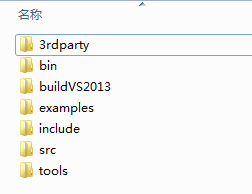Windows下用VS2013載入caffemodel做影象分類
阿新 • • 發佈:2019-02-13
結果顯示在左上角,有英文和中文兩種標籤可選,如果顯示中文,需要使用Freetype庫,請自行百度。


最後,可以刪除那些不需要的檔案或資料夾,如我的caffe-windows-master內只留下:
#include <caffe/caffe.hpp> #include <opencv2/core/core.hpp> #include <opencv2/highgui/highgui.hpp> #include <opencv2/imgproc/imgproc.hpp> #include <iosfwd> #include <memory> #include <utility> #include <vector> #include <iostream> #include <string> #include <sstream> #include "CvxText.h" //英文標籤去掉該標頭檔案 using namespace caffe; // NOLINT(build/namespaces) using std::string; /* Pair (label, confidence) representing a prediction. */ typedef std::pair<string, float> Prediction; class Classifier { public: Classifier(const string& model_file, const string& trained_file, const string& mean_file, const string& label_file); std::vector<Prediction> Classify(const cv::Mat& img, int N = 5); private: void SetMean(const string& mean_file); std::vector<float> Predict(const cv::Mat& img); void WrapInputLayer(std::vector<cv::Mat>* input_channels); void Preprocess(const cv::Mat& img, std::vector<cv::Mat>* input_channels); private: shared_ptr<Net<float> > net_; cv::Size input_geometry_; int num_channels_; cv::Mat mean_; std::vector<string> labels_; }; Classifier::Classifier(const string& model_file, const string& trained_file, const string& mean_file, const string& label_file) { #ifdef CPU_ONLY Caffe::set_mode(Caffe::CPU); #else Caffe::set_mode(Caffe::GPU); #endif /* Load the network. */ net_.reset(new Net<float>(model_file, TEST)); net_->CopyTrainedLayersFrom(trained_file); CHECK_EQ(net_->num_inputs(), 1) << "Network should have exactly one input."; CHECK_EQ(net_->num_outputs(), 1) << "Network should have exactly one output."; Blob<float>* input_layer = net_->input_blobs()[0]; num_channels_ = input_layer->channels(); CHECK(num_channels_ == 3 || num_channels_ == 1) << "Input layer should have 1 or 3 channels."; input_geometry_ = cv::Size(input_layer->width(), input_layer->height()); /* Load the binaryproto mean file. */ SetMean(mean_file); /* Load labels. */ std::ifstream labels(label_file); CHECK(labels) << "Unable to open labels file " << label_file; string line; while (std::getline(labels, line)) labels_.push_back(string(line)); Blob<float>* output_layer = net_->output_blobs()[0]; CHECK_EQ(labels_.size(), output_layer->channels()) << "Number of labels is different from the output layer dimension."; } static bool PairCompare(const std::pair<float, int>& lhs, const std::pair<float, int>& rhs) { return lhs.first > rhs.first; } /* Return the indices of the top N values of vector v. */ static std::vector<int> Argmax(const std::vector<float>& v, int N) { std::vector<std::pair<float, int> > pairs; for (size_t i = 0; i < v.size(); ++i) pairs.push_back(std::make_pair(v[i], i)); std::partial_sort(pairs.begin(), pairs.begin() + N, pairs.end(), PairCompare); std::vector<int> result; for (int i = 0; i < N; ++i) result.push_back(pairs[i].second); return result; } /* Return the top N predictions. */ std::vector<Prediction> Classifier::Classify(const cv::Mat& img, int N) { std::vector<float> output = Predict(img); std::vector<int> maxN = Argmax(output, N); std::vector<Prediction> predictions; for (int i = 0; i < N; ++i) { int idx = maxN[i]; predictions.push_back(std::make_pair(labels_[idx], output[idx])); } return predictions; } /* Load the mean file in binaryproto format. */ void Classifier::SetMean(const string& mean_file) { BlobProto blob_proto; ReadProtoFromBinaryFileOrDie(mean_file.c_str(), &blob_proto); /* Convert from BlobProto to Blob<float> */ Blob<float> mean_blob; mean_blob.FromProto(blob_proto); CHECK_EQ(mean_blob.channels(), num_channels_) << "Number of channels of mean file doesn't match input layer."; /* The format of the mean file is planar 32-bit float BGR or grayscale. */ std::vector<cv::Mat> channels; float* data = mean_blob.mutable_cpu_data(); for (int i = 0; i < num_channels_; ++i) { /* Extract an individual channel. */ cv::Mat channel(mean_blob.height(), mean_blob.width(), CV_32FC1, data); channels.push_back(channel); data += mean_blob.height() * mean_blob.width(); } /* Merge the separate channels into a single image. */ cv::Mat mean; cv::merge(channels, mean); /* Compute the global mean pixel value and create a mean image * filled with this value. */ cv::Scalar channel_mean = cv::mean(mean); mean_ = cv::Mat(input_geometry_, mean.type(), channel_mean); } std::vector<float> Classifier::Predict(const cv::Mat& img) { Blob<float>* input_layer = net_->input_blobs()[0]; input_layer->Reshape(1, num_channels_, input_geometry_.height, input_geometry_.width); /* Forward dimension change to all layers. */ net_->Reshape(); std::vector<cv::Mat> input_channels; WrapInputLayer(&input_channels); Preprocess(img, &input_channels); net_->ForwardPrefilled(); /* Copy the output layer to a std::vector */ Blob<float>* output_layer = net_->output_blobs()[0]; const float* begin = output_layer->cpu_data(); const float* end = begin + output_layer->channels(); return std::vector<float>(begin, end); } /* Wrap the input layer of the network in separate cv::Mat objects * (one per channel). This way we save one memcpy operation and we * don't need to rely on cudaMemcpy2D. The last preprocessing * operation will write the separate channels directly to the input * layer. */ void Classifier::WrapInputLayer(std::vector<cv::Mat>* input_channels) { Blob<float>* input_layer = net_->input_blobs()[0]; int width = input_layer->width(); int height = input_layer->height(); float* input_data = input_layer->mutable_cpu_data(); for (int i = 0; i < input_layer->channels(); ++i) { cv::Mat channel(height, width, CV_32FC1, input_data); input_channels->push_back(channel); input_data += width * height; } } void Classifier::Preprocess(const cv::Mat& img, std::vector<cv::Mat>* input_channels) { /* Convert the input image to the input image format of the network. */ cv::Mat sample; if (img.channels() == 3 && num_channels_ == 1) cv::cvtColor(img, sample, CV_BGR2GRAY); else if (img.channels() == 4 && num_channels_ == 1) cv::cvtColor(img, sample, CV_BGRA2GRAY); else if (img.channels() == 4 && num_channels_ == 3) cv::cvtColor(img, sample, CV_BGRA2BGR); else if (img.channels() == 1 && num_channels_ == 3) cv::cvtColor(img, sample, CV_GRAY2BGR); else sample = img; cv::Mat sample_resized; if (sample.size() != input_geometry_) cv::resize(sample, sample_resized, input_geometry_); else sample_resized = sample; cv::Mat sample_float; if (num_channels_ == 3) sample_resized.convertTo(sample_float, CV_32FC3); else sample_resized.convertTo(sample_float, CV_32FC1); cv::Mat sample_normalized; cv::subtract(sample_float, mean_, sample_normalized); /* This operation will write the separate BGR planes directly to the * input layer of the network because it is wrapped by the cv::Mat * objects in input_channels. */ cv::split(sample_normalized, *input_channels); CHECK(reinterpret_cast<float*>(input_channels->at(0).data) == net_->input_blobs()[0]->cpu_data()) << "Input channels are not wrapping the input layer of the network."; } //獲取路徑path下的檔案,並儲存在files容器中 void getFiles(string path, vector<string>& files) { //檔案控制代碼 long hFile = 0; //檔案資訊 struct _finddata_t fileinfo; string p; if ((hFile = _findfirst(p.assign(path).append("\\*").c_str(), &fileinfo)) != -1) { do { if ((fileinfo.attrib & _A_SUBDIR)) { if (strcmp(fileinfo.name, ".") != 0 && strcmp(fileinfo.name, "..") != 0) getFiles(p.assign(path).append("\\").append(fileinfo.name), files); } else { files.push_back(p.assign(path).append("\\").append(fileinfo.name)); } } while (_findnext(hFile, &fileinfo) == 0); _findclose(hFile); } } int main(int argc, char** argv) { //caffe的準備工作 #ifdef _MSC_VER #pragma comment( linker, "/subsystem:\"windows\" /entry:\"mainCRTStartup\"" ) #endif //::google::InitGoogleLogging(argv[0]); string model_file("../../model/deploy.prototxt"); string trained_file("../../model/type.caffemodel"); string mean_file("../../model/type_mean.binaryproto"); string label_file("../../model/labels.txt"); string picture_path("../../type"); Classifier classifier(model_file, trained_file, mean_file, label_file); vector<string> files; getFiles(picture_path, files); for (int i = 0; i < files.size(); i++) { cv::Mat img = cv::imread(files[i], -1); cv::Mat img2; std::vector<Prediction> predictions = classifier.Classify(img); Prediction p = predictions[0]; CvSize sz; sz.width = img.cols; sz.height = img.rows; float scal = 0; scal = sz.width > sz.height ? (300.0 / (float)sz.height) : (300.0 / (float)sz.width); sz.width *= scal; sz.height *= scal; resize(img, img2, sz, 0, 0, CV_INTER_LINEAR); IplImage* show = cvCreateImage(sz, IPL_DEPTH_8U, 3); string text = p.first; char buff[20]; _gcvt(p.second, 4, buff); text = text + ":" + buff; /************************輸出中文(用到Freetype庫)****************************/ /*CvxText mytext("../../STZHONGS.TTF");// 字型檔案 const char *msg = text.c_str(); CvScalar size; size.val[0] = 26; size.val[1] = 0.5; size.val[2] = 0.1; size.val[3] = 0; mytext.setFont(NULL,&size, NULL, NULL); // 設定字型大小 mytext.putText(&IplImage(img2), msg, cvPoint(10, 30), cvScalar(0, 0, 255, NULL)); //輸出影象名 text = files[i].substr(files[i].find_last_of("\\")+1); msg = text.c_str(); mytext.putText(&IplImage(img2), msg, cvPoint(10, 55), cvScalar(0, 0, 255, NULL)); cvCopy(&(IplImage)img2, show);*/ /*******************************************************************************/ /***************************輸出英文標籤*****************************************/ cvCopy(&(IplImage)img2, show); CvFont font; cvInitFont(&font, CV_FONT_HERSHEY_COMPLEX, 1.0, 1.0, 0, 2, 8); //初始化字型 cvPutText(show, text.c_str(), cvPoint(10, 30), &font, cvScalar(0, 0, 255, NULL)); text = files[i].substr(files[i].find_last_of("\\")+1); cvPutText(show, text.c_str(), cvPoint(10, 55), &font, cvScalar(0, 0, 255, NULL)); /**********************************************************************************/ cvNamedWindow("結果展示"); cvShowImage("結果展示", show); int c = cvWaitKey(); cvDestroyWindow("結果展示"); cvReleaseImage(&show); if (c == 27) { return 0; } } return 0; }
3.生成
設定好之後,右鍵caffelib,生成。
4.結果
左邊是中文標籤,右邊是英文標籤。

最後,可以刪除那些不需要的檔案或資料夾,如我的caffe-windows-master內只留下:
將Classification\CLassificationDLL\bin加入環境變數,然後加入你的模型檔案即可。

